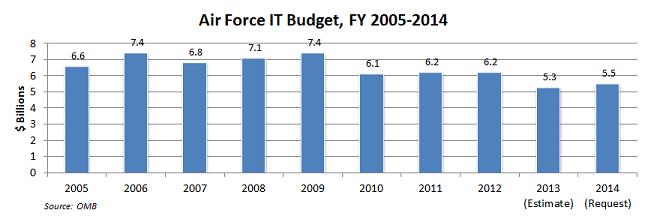FY 2014 Air Force IT Budget – Will Declines Continue?
Published: April 24, 2013
USAFBudgetForecasts and SpendingOMB
Like so many areas within the Department of Defense, pressure to reduce budgets for information technology (IT) is likely to take its toll on the Air Force in FY 2014. Consistently with the smallest IT budget among the four defense components, the Air Force is again under pressure to reduce its IT spending.
Air Force IT Budget Highlights
- Total IT request decreases $749M or 12.0% from FY 2012-14. The FY 2013-14 budget increases is $202M or 3.8%. The FY 2012-13 decrease was $951M or 15.2%
- New development (DME) decreases $57M or -3.4% from FY 2012-14. The FY 2013-14 level increases $71M or +4.5%.
- Operation and Maintenance (O&M) or Steady State (SS) decreases $639M or 15.2% from FY 2012-14, although FY 2013-14 sees an increase of $130M or 3.5%.
Historical Perspective
For a bit of a historical perspective the chart below depicts the Air Force IT budget over the last decade. In recent years they have trended toward having a budget step-down every third year, or so.

The compound annual growth rate (CAGR) from FY 2005-2009 was 3%. In stark contrast, the CAGR from FY 2010-2014 was -3% -- a 6 percentage point swing, which results in an overall FY 2005-2014 CAGR of -2%.
Even though the FY 2014 IT budget request for Air Force includes a $200 million increase over FY 2013 it may be unlikely that such an increase will materialize, given recent history. Comparing the Air Force’s yearly IT budget request to what it eventually receives shows that they generally tend to receive several hundred million dollars less than they request. (See chart below.) This general trend of makes the Air Force stand out from the Army and Navy, which tended to receive more than requested over the same time frame.

Setting Priorities
As we might expect, even with tightening budgets some priority programs get increases and involve new development activities. The following initiatives have some of the largest budget increases over the last few years and also include a significant portion of development funding (DME.)

On the other side come several program reductions. At Air Force, these cuts impact a wide range of systems and programs with the financial and legacy systems among the most common. The following programs are slated to have their budgets reduced to zero in the coming fiscal year.

Communications-related spending is also scheduled for reductions at the Air Force. Several base level communications infrastructure programs may see a reduction in their budgets equally a third or more compared to FY 2012 levels.

As has been the case for several budget cycles now, ongoing pressure will push the Air Force and other Defense components to make decisions between priorities. It appears that the impacts of this priority-setting is already quite visible in the Air Force’s IT budget proposal for FY 2014.